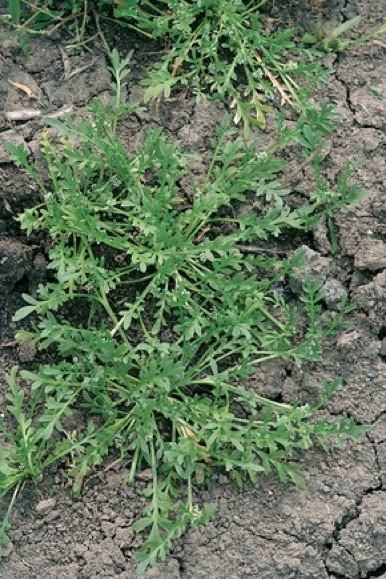
Coronopus didymus, strong flavor, naughty name. Photo by Green Deane
Coronopus didymus, C. squamatus: Smelly Pot Herbs?
Opinions are mixed on Swinecress. I think it’s a nice walkabout nibble and pot herb. I often find it in lawns in the cooler months of the year and take it home with me. Others think it stinks nauseatingly and you should put a clothespin on your nose while boiling it …many times. Now you know the spectrum of gustatory opinions.

Coronopus Squamatus
Swinecress is yet another micro-mustard one finds clinging to life in scattered little patches. Don’t let the size fool you. It is a tenacious plant in will-to-live and flavor. Actually there are two species in North America, neither of them native. Coronopus didymus probably came from South America and Coronopus squamatus (formerly C. procumbens) came from Europe. They both have a moderate to strong mustard flavor and are used the same way. Sometimes the C. didymus is called the “Lesser Swinecress.” No idea why. Their main separating distinction is the fruit/seeds of the C. squamatus is lumpy and has ridges where as the C. didymus tends to be smooth.
While both are found scattered in the Eastern United States, C. squamatus is also sprinkled across Europe. It is found from Ireland and southern England over to near my ancestral grounds in Greece, the wetlands of Mt. Parnon in Peloponnisos. C. didymus is also found in Oregon, Arizona and California. In the latter two states it is a noxious weed. It’s also been introduce to South Africa and Australia
Calling these plants micro-mustards is not quite fair. When they live where they are walked on or mowed they indeed become tough little contenders. But, given all the things most plants like such as sun, water, good soil and not trod upon they can grow to over a foot hight. Oddly, they take up salt in their roots, up to 17 percent. Those roots can be ground up and mixed with vinegar for a type of horseradish. Or they can be cooked and eaten. While I do not know so the roots might also be burned for the salt. Other plants are burned for salt.
Coronopus (kor-on-OH-puss) is from Greek and means Raven/crow’s foot, presumably because the ends of the leaves look like that. Not too many people look at crows’ feet these days, or Ravens’. Didymus (DID-ee-mus) means found in pairs, a reference to the seeds, as in two testes and indeed that is what the seed pod resembles. Squamatus (squa-MAY-tus) means with scale-like leaves or bracts.
By the way, there are no poisonous members of the mustard family, just pungent.
Green Deane’s “Itemized” Plant Profile
IDENTIFICATION: Coronopus didymus: An annual or winter annual, low, spreading, smooth to mildly hair, stems freely branching, low-growing with upward tips, many leaves, ovate to oblong, pinnatifid, segments narrow, dentate or incised, racemes many, lots of flowers, white petals. Fruit shorter than stalks, seeds in two inflated rounded sections. Coronopus squamatus similar, more leafy, basal leaves obvate to oblanceolate, very condensed flowers. Seeds much rougher than C. didymus which are smooth.
TIME OF YEAR: C. didymus flowers spring to mid-summer. C. squamatus flowers in summer. In Florida, Swinecress a winter annual easily found in January.
ENVIRONMENT: Old fields, roadsides, along streets, vacant lots, disturbed sites, mowed lawns, often locally abundant.
METHOD OF PREPARATION: Depends on your taste and perception. Can be eaten raw. Most people boil leaves and stems in several changes of water as a pot herb. Seems excessive to me. I actually never cook it. Can be used to stuff other foods such as fish. Roots can be cooked or ground up and mixed with vinegar to be used like a horseradish. Do not add salt to the root until you taste it.


Very informative post! Just realizing the “weeds” I’ve been pulling from my potted plants for years are the hairy bittercress! Thought they looked brassica-ish due to the seed pods. Been studying watercress due to my intent to grow it soon and noticed the similarities to the “weed” in question. Now I will munch on it when removing bunches from potted plants! Thanks!
Also grows here in Hawai’i. In fact, and coiencidentally we harvested some yesterday to include in a salad. Thank you for the write up on this one.
these are really nice. I always thought they were a part of the carrot family. Now I know. I eat them raw, they’re really nice in taste – very strong and heals the body. These are plants that are smart in healing and helping, but not in the decision-making department.
Lesser swinecress tastes a lot to me
like slightly hot radish when eaten raw.
I was given some seed to this many years ago and just threw in in an unplanted part of the garden. I didn’t remember what the label said it was and now I know. I find if it is well watered it has a milder flavor.